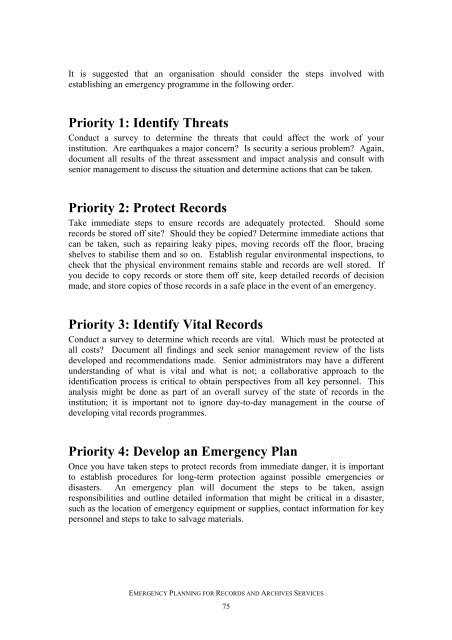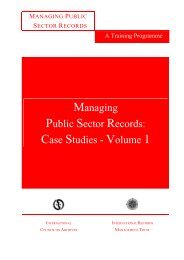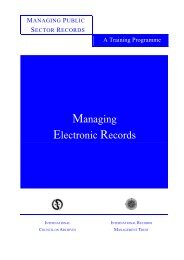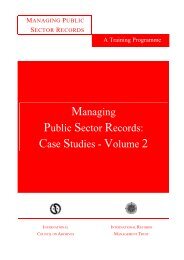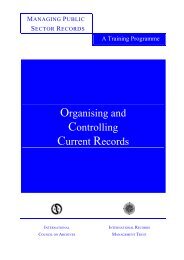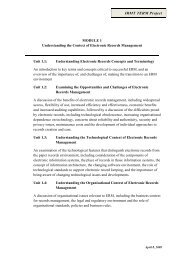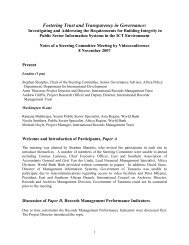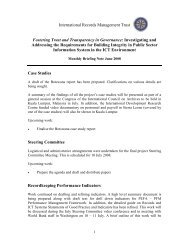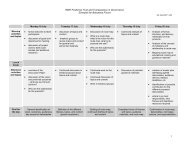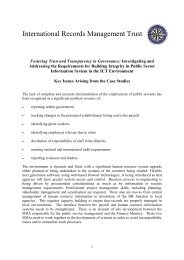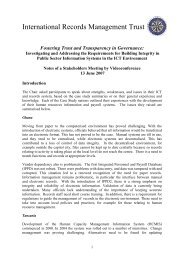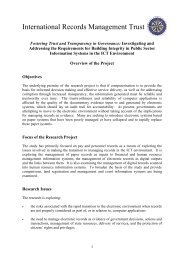disaster planning and control - International Records Management ...
disaster planning and control - International Records Management ...
disaster planning and control - International Records Management ...
Create successful ePaper yourself
Turn your PDF publications into a flip-book with our unique Google optimized e-Paper software.
It is suggested that an organisation should consider the steps involved with<br />
establishing an emergency programme in the following order.<br />
Priority 1: Identify Threats<br />
Conduct a survey to determine the threats that could affect the work of your<br />
institution. Are earthquakes a major concern? Is security a serious problem? Again,<br />
document all results of the threat assessment <strong>and</strong> impact analysis <strong>and</strong> consult with<br />
senior management to discuss the situation <strong>and</strong> determine actions that can be taken.<br />
Priority 2: Protect <strong>Records</strong><br />
Take immediate steps to ensure records are adequately protected. Should some<br />
records be stored off site? Should they be copied? Determine immediate actions that<br />
can be taken, such as repairing leaky pipes, moving records off the floor, bracing<br />
shelves to stabilise them <strong>and</strong> so on. Establish regular environmental inspections, to<br />
check that the physical environment remains stable <strong>and</strong> records are well stored. If<br />
you decide to copy records or store them off site, keep detailed records of decision<br />
made, <strong>and</strong> store copies of those records in a safe place in the event of an emergency.<br />
Priority 3: Identify Vital <strong>Records</strong><br />
Conduct a survey to determine which records are vital. Which must be protected at<br />
all costs? Document all findings <strong>and</strong> seek senior management review of the lists<br />
developed <strong>and</strong> recommendations made. Senior administrators may have a different<br />
underst<strong>and</strong>ing of what is vital <strong>and</strong> what is not; a collaborative approach to the<br />
identification process is critical to obtain perspectives from all key personnel. This<br />
analysis might be done as part of an overall survey of the state of records in the<br />
institution; it is important not to ignore day-to-day management in the course of<br />
developing vital records programmes.<br />
Priority 4: Develop an Emergency Plan<br />
Once you have taken steps to protect records from immediate danger, it is important<br />
to establish procedures for long-term protection against possible emergencies or<br />
<strong>disaster</strong>s. An emergency plan will document the steps to be taken, assign<br />
responsibilities <strong>and</strong> outline detailed information that might be critical in a <strong>disaster</strong>,<br />
such as the location of emergency equipment or supplies, contact information for key<br />
personnel <strong>and</strong> steps to take to salvage materials.<br />
EMERGENCY PLANNING FOR RECORDS AND ARCHIVES SERVICES<br />
75


